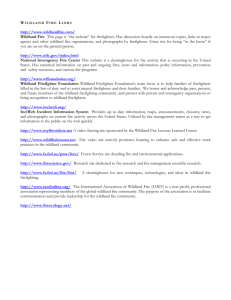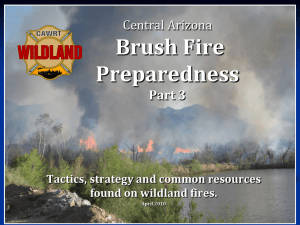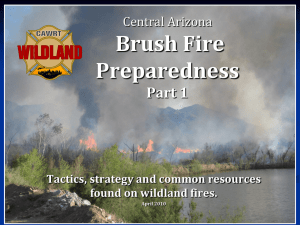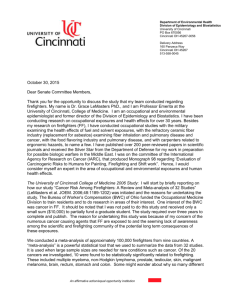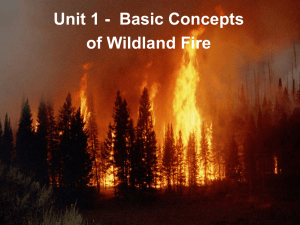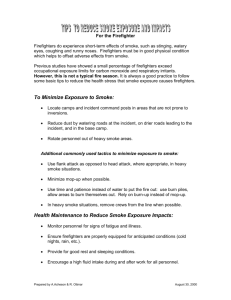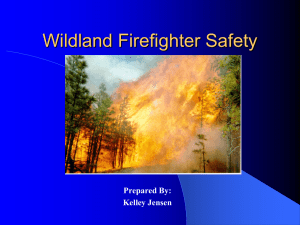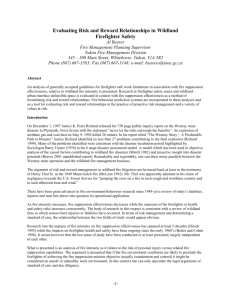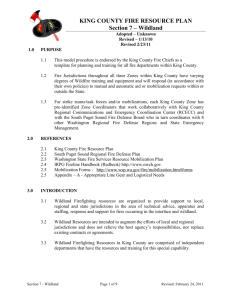Example 2
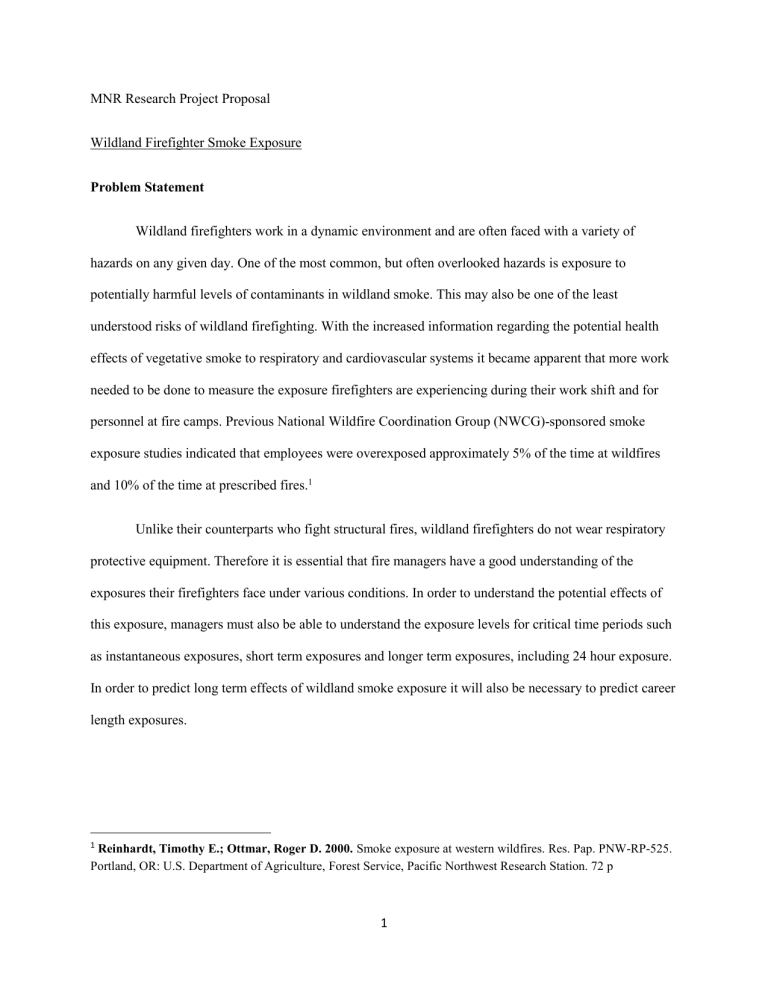
MNR Research Project Proposal
Wildland Firefighter Smoke Exposure
Problem Statement
Wildland firefighters work in a dynamic environment and are often faced with a variety of hazards on any given day. One of the most common, but often overlooked hazards is exposure to potentially harmful levels of contaminants in wildland smoke. This may also be one of the least understood risks of wildland firefighting. With the increased information regarding the potential health effects of vegetative smoke to respiratory and cardiovascular systems it became apparent that more work needed to be done to measure the exposure firefighters are experiencing during their work shift and for personnel at fire camps. Previous National Wildfire Coordination Group (NWCG)-sponsored smoke exposure studies indicated that employees were overexposed approximately 5% of the time at wildfires and 10% of the time at prescribed fires.
1
Unlike their counterparts who fight structural fires, wildland firefighters do not wear respiratory protective equipment. Therefore it is essential that fire managers have a good understanding of the exposures their firefighters face under various conditions. In order to understand the potential effects of this exposure, managers must also be able to understand the exposure levels for critical time periods such as instantaneous exposures, short term exposures and longer term exposures, including 24 hour exposure.
In order to predict long term effects of wildland smoke exposure it will also be necessary to predict career length exposures.
1
Reinhardt, Timothy E.; Ottmar, Roger D. 2000. Smoke exposure at western wildfires. Res. Pap. PNW-RP-525.
Portland, OR: U.S. Department of Agriculture, Forest Service, Pacific Northwest Research Station. 72 p
1
Objective
The objective of this study is to expand the current state of knowledge on wildland firefighter smoke exposure. First of all it will provide important information on the levels of irritants firefighters are exposed to. In order for fire managers and safety and health managers to develop safe exposure levels and mitigation measures to protect wildland firefighters they must be able to understand the critical factors that influence exposure levels to firefighters. This research will measure the exposure levels of carbon monoxide (CO), particulate matter (PM4) and crystalline silica (SiO
2
) on wildland and prescribed fires in several geographic areas of the United States.
Previous research and current knowledge
The first section of this paper will provide an overview of previous research done on wildland firefighters and include a discussion of the health effects of smoke on humans. This will include research done in the wildland fire environment and other relevant research. This section will also include a discussion of the health effects of smoke exposure and existing regulatory statutes and guidelines published by the Occupational Safety and Health Administration as well as the American Conference of
Governmental Industrial Hygienists. Finally a brief discussion on the lack of published guidelines for wildland firefighter smoke exposure levels will be presented.
Project design
Due to the wide range of conditions wildland firefighters work in and the numerous activities they undertake, the field sampling design must be developed so that the appropriate analysis can be done.
The project development and design will be presented and the field data collection protocols will be discussed. Field work for this type of research requires focus on training, protocols and logistics.
Successful field work in a dynamic environment such as wildland fires requires the cooperation and support of various individuals and groups. This section will provide a thorough discussion of the field
2
work, geographic scope, the amount and type of data that was gathered and identify key individuals and groups involved in this research.
Statistical analysis
This section will provide the analysis of the field data collected to date. Based on the project design and data collection protocols key metrics of firefighter exposures will be presented. These will include the maximum exposures of CO for various timeframes of interest as well as exposures for PM4 and SiO
2
. Field data will enable the analysis to provide maximum CO exposure levels for the following; 5 minute exposures, 8 hour exposures, fireline exposures, and shift exposures. Exposures levels for PM4 and SiO
2 will be determined for the amount of time firefighters are actually on the fireline. Descriptive statistics commonly used by industrial hygienists will be used for the data analysis.
Health and safety concerns
Based on the findings of this research a discussion on the potential health effects of exposure to
CO, PM4 and SiO
2
will be presented. Most of the research done on exposure to smoke involves situations and populations that are considerably different from wildland fires. Extrapolating the results from this project based on dissimilar research will be problematic yet could be inform further research on wildland firefighter exposure.
Fire Management Implications
If this research provides sufficient evidence that there are times where wildland firefighters’ exposure to harmful irritants exceeds established exposure limits fire managers must act on this information. Firefighter safety is always the first priority for fire managers. However, exposure to smoke oftentimes is not a factor in determining strategy and tactics when managing wildland fires. If sufficient data is collected that allows the analysis to identify specific scenarios where potentially harmful exposures may occur, this project can provide fire managers an important piece of information when
3
developing suppression strategies and prescribed fire burn plans. Fire managers may be able to mitigate situations that would likely put firefighters in harm’s way or avoid those situations all together. Incident
Management Teams that manage large fires in the US go through a process of identifying known or expected hazards prior to developing the daily shift plan. Each hazard must be mitigated prior to assigning firefighters to the task or area where the hazard exists. Smoke exposure is not one of the hazards evaluated during this exercise. This project may provide the information necessary to make smoke exposure a routine hazard evaluation criterion.
Human dimensions
Many wildland firefighters consider smoke exposure an unavoidable and natural consequence of fighting fire. Reviews of wildland fire accidents and fatalities have attributed a “can do” attitude as a contributing factor in many tragic events in wildland firefighting. As a result of the lessons learned from wildland fatalities, management has put a greater emphasis on safety and empowered employees to turn down assignments they consider unsafe. Should the information gained from this project show there is greater risk from wildland smoke than previously believed firefighters may want to consider smoke exposure as another criterion to be evaluated when accepting or denying assignments. Firefighters may also need to have a greater say in how and when fire suppression activities occur.
Policy implications
Federal and state regulations prohibit employers from knowingly exposing their employees to life threatening situations. Employers must remove or mitigate these hazards. Federal agencies with wildland fire suppression responsibility may need to consider how best to protect their workforce from harmful levels of irritants in wildland smoke.
4
